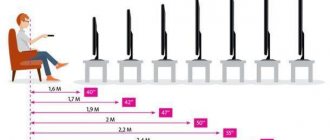The main differences between plasma and LCD TV are:
- Screen response - plasma has much less response than LCD
- Viewing angle - for the LCD screen, it is no more than 160-180 degrees
- Electricity consumption - LCD TVs are more economical
- Service life - the service life of plasma TVs is much shorter.
Plasma also differs from LCD TV in production technology. Let's look at all the positive and negative features in the article.
It is difficult for an ordinary consumer to understand the difference between a plasma and an LCD TV. Visually these devices are identical. They have similar characteristics, interface and different operating principles.
Plasma panels on TV
Such devices consist of two glass panels, where in the center there is a cellular matrix with ionized gas.
Transparent electrodes supply electricity to the cells. Gas converted to plasma has a characteristic glow.
It is he who begins to emit ultraviolet light. The phosphor converts it into red, green and blue colors. The remaining shades are obtained by combining these three colors.
So what is the difference between an LCD TV and a plasma TV? Most companies are still producing plasma TVs, but their number is decreasing every year.
This technology is considered outdated; the technology should have a large screen diagonal, since it is impossible to achieve high picture resolution on a small one. Such devices have their advantages and disadvantages.
Let's look at the positive qualities of a plasma TV:
- Long service life - up to 30 years.
- Better contrast and detail of the picture thanks to a wide viewing angle (160-170 degrees).
- Support for 3D technology.
- Convenience - plasma panels, the screen size of which is no more than a meter, will have a thickness of 10 to 12 cm.
- Plasma TVs are absolutely harmless to both humans and pets. They do not create magnetic fields and do not emit x-rays.
Despite all the advantages, there are also disadvantages:
- High electricity consumption.
- High price.
- Plasma TVs that have a fan will make noise when operating.
- Pixel burnout in a static image.
Conclusions TheDifference.ru
- Screen refresh time: Plasma leads the way with significantly faster screen refresh times
- Viewing Angle: Plasma leads the way with a wide viewing angle
- Image burn-in: LCD is in the lead, because burns out twice as slow
- Energy consumption and heat dissipation: LCD leads the way with lower power consumption and heat dissipation
- Contrast and lighting uniformity: Plasma leads the way with higher contrast and lighting uniformity
- Size: plasma = LCD
Good luck with your choice!
LCD TVs
This technique has a liquid crystal display and lamp backlight. The screen in such TVs is an active matrix, which looks like two transparent plates with liquid crystals in the center.
The plates contain transparent electrodes that supply voltage to the cells of the matrix. In addition, all plates have polarizers and backlighting. It can be LED or fluorescent.
Polarizers regulate the flow of light in the horizontal or vertical plane. The light beam under the influence of a color filter acquires one of the shades.
The main advantages of LCD TVs include:
- Economical energy consumption.
- Long service life, about 20 years.
- Affordable price, even for devices with large screens.
- Light weight and thin screen allow LCD TVs to be installed anywhere.
Now let's look at the cons:
- Small viewing angle.
- Low screen contrast.
- Slow response speed.
- There is no option to change the resolution.
Types of LCD panels
There are three leading technologies on the market today, all devices differ in characteristics and price.
The technology used in budget models is considered outdated, but they are still popular due to their affordability and practicality.
Let's look at the main models that manufacturers offer to consumers today.
These include:
- LCD is the first type of LCD panels. It has a simple set of functions and is low cost. The brightness and saturation of colors directly depends on the viewing angle. But such devices do not have the main disadvantages, such as screen flickering, harmful electromagnetic radiation, heavy weight, and geometric image distortion.
- LED TVs are standard TVs with an LCD screen; the matrix is illuminated by special LEDs. Such devices are distinguished by higher clarity parameters and have LED backlighting located in the end part or throughout the matrix.
- OLED - the main feature of this technology is that such devices do not need additional backlighting. To create them, thin films consisting of several layers of carbon material are used.
What is Smart TV and its advantages
Smart TV is an option that allows you to:
- access the Internet to watch videos, visit websites, etc.;
- connect all devices into a home network with files displayed on the big screen;
- visit social networks;
- communicate via Skype;
- use applications to expand the functionality of the device.
Smart TV is a technology for integrating the Internet and digital interactive services.
However, for such opportunities you will have to overpay a significant amount compared to other models that do not support the option.
When purchasing such a TV, you should take into account that through Smart TV the user begins to be “followed” in order to advertise their own services. For those who are concerned about anonymity, it is better not to purchase this device. Even if a model has a function to disable tracking, this does not guarantee that it will actually be deactivated.
Video - Comparing Smart TV systems
Differences between LCD and plasma on TV
Now that we know the operating features of these devices, let’s talk about how plasma differs from an LCD TV.
Screen refresh time
In plasma devices it is much smaller; the picture on the screen changes almost immediately. For LCD TVs, the loop effect has long been considered a problem, but thanks to recent technologies it has been reduced to 8 ms, which is almost imperceptible to humans.
Weight
LCD TVs are compact and lightweight, while plasmas are limited in size. The first devices also weigh much less. Plasmas, in turn, are equipped with glass displays, which simplifies the process of wall mounting.
Viewing angle
According to this indicator, LCD TVs have been inferior to plasma panels for a long time. When exceeding 160-180 degrees, the screen brightens or darkens. Whereas for plasma panels the viewing angle is not limited.
Electricity consumption
When choosing, pay attention to this parameter. LCD TVs consume much less electricity.
Brightness level and contrast of the image displayed on the screen
Plasma panels, which do not have a backlight, produce deep blacks and a bright, rich picture from any viewing angle.
LCD models, on the contrary, produce a dark, gray color due to the backlight and the picture on the screen will be paler. The only exceptions are OLED models without backlight.
Lifetime
For LCD TVs it is 70,000-100,000 hours. During repairs, it is enough to replace the lamp, not the entire screen.
The operating time of plasma devices ranges from 30,000-60,000 hours.
Image burn-in
On average, an LCD panel is 80 thousand hours, and a plasma panel is about 40 thousand hours. But 40 hours is enough to allow you to watch TV for up to 10 hours even with active use.
Price
With all the same characteristics, LCD TVs are more expensive.
Picture quality
The key point when choosing a TV is the picture quality. What is the difference between a plasma and LCD TV, if you use this indicator for comparison?
This leads to a fairly clear answer. Plasma TVs have the best picture quality. The superiority is obvious even when compared with the most advanced LCD models. Users may notice this feature if they look at how black is displayed on plasma models. It is much clearer and deeper. The contrast is quite high. This nuance will ensure that even dark movie scenes are viewed “excellently”.
This difference can be explained by the design features inherent in LCD TVs. There is a backlight on the screen behind the image; it is completely impossible to turn it off, and it is impossible to get truly black pixels.
LCD or plasma, which to choose?
Plasma panels have a standard set of functions and are distinguished by high image quality. They are suitable for movie buffs or if you are planning to install a large screen home theater in your home.
The range of such devices on the market is not very diverse, while LCD TVs come in a wide variety of models.
If contrast and color saturation play an important role for you, then you should choose plasma panels.
LCD displays are inferior to plasma panels in image brightness and dynamism. But if you are on a limited budget, they will be the best option. Due to low energy consumption and long service life, such a TV can often be seen in various public institutions: bars, cafes, shops.
If you don’t know what to choose LED, plasma or LCD for installation in the living room or bedroom, then give preference to the first option. The second choice is LCD. LCD screens will fade in strong daylight, but expensive models have a special coating that avoids this problem.
When making a choice, take into account a number of characteristics. They need to be considered comprehensively and pay attention to small details.
Knowing how LCD TVs differ from plasma, the disadvantages and advantages of the two technologies, you can make a choice based on personal preferences.
Features of work
Plasma panels and LCD TVs differ in a number of criteria, and the main one is their operating features.
Plasma panel
Each pixel in the plasma consists of 3 microlamps filled with ionized gas. An electrode is connected to these cones, through which voltage is supplied. Under the influence of electrical voltage, the gas in the cones causes the phosphor to glow (covering each subpixel). And the brightness of the image depends on the level of supplied electricity.
LCD TV
Based on the principle of operation, LCD displays resemble window blinds, allowing the amount of light through them to be adjusted to the angle of openness. However, blinds do this synchronously, while LCD cells do this separately.
Behind the array or on the side of the cells are light sources, often light emitting diodes (LEDs), and directly in front of them are 3-color RGD filters that give the transmitted light the desired color.
What else should you pay attention to when choosing a TV?
There are a number of features that are not technical characteristics, but are important when choosing.
Availability of multimedia connectors
Plasma models most often have HDMI, SCART, USB connectors, which significantly expand the possibilities of using the equipment.
Here's what they can provide:
- Using HDM, you can broadcast a picture from a computer, smartphone, or laptop to a TV.
- USB allows you to connect a flash drive to your equipment and read information from the media.
- SCART is a connector that is compatible with all known multimedia. It allows you to both transmit information and record it.
When choosing, pay attention to where the connector is located. If it is brought forward, it will be much more convenient to use the TV.
Supports 3D and SmartTV modes
3D mode allows you to see the image in three dimensions. Plasma TVs have this feature. But you can watch programs in this format only by pre-recording them.
3D is not the most necessary function, although it is useful.
Manufacturer
Today, different companies produce televisions. The main producing countries are Japan and South Korea. The first one employs such well-known companies as Sony , Sharp , and Panasonic .
Japanese companies supply products that are known throughout the world for their quality and reliability.
For example, it manufactures all components for its products independently, without entrusting production to third-party companies.
The most famous company producing TVs in South Korea is LG, the manufacturer received an award in Las Vegas for producing the best device. The brand is the most optimal combination of price and quality.
When purchasing products from little-known and dubious companies, there is a risk of receiving equipment with a short service life.
Summarizing
Thus, it is not so difficult to determine which is better - a plasma or LCD TV. The last option is considered universal. New technologies and developments have brought image quality closer to the level of plasma devices; they are more economical and cost less.
On the other hand, plasma TVs have a number of additional features that LCD TVs do not have. The final decision must be made based on personal preferences and the set of desired characteristics.
Voting for the best TV
Which TV would you choose or recommend?
Sony KD-55AG9
25.00 % ( 1 )
Sony KD-55XG9505
0.00 % ( 0 )
TCL L43S6500
0.00 % ( 0 )
LG PZ950S
0.00 % ( 0 )
Samsung PS59D8000
0.00 % ( 0 )
Fujitsu Siemens MYRICA PQ50-1
0.00 % ( 0 )
Samsung QE55Q9FNA
0.00 % ( 0 )
LG OLED55C8
0.00 % ( 0 )
Sony KD-49XF9005
0.00 % ( 0 )
Samsung UE49NU7100U
0.00 % ( 0 )
Xiaomi Mi TV 4S 43 T2
0.00 % ( 0 )
Sony KDL-43WF665
0.00 % ( 0 )
JVC LT-40M650
25.00 % ( 1 )











